Rattle Fire Photos
The Rattle Fire in the Boulder Creek Wilderness was less than 1,000 acres and under control at the end of August this summer. Then the fire management team was ordered off because they had done too good a job of suppression. The Rattle Fire was Let Burn and eventually charred more than 20,000 acres. Most of the 19,100-acre BC Wilderness was roasted, and the fire spread out of the designated wilderness area to the west, south, and east. Much of the 16,500-acre 1996 Spring Burn was reburned.
A priceless, heritage, Oregon old-growth forest has thus been destroyed by repeated fires. There was no attempt to rehabilitate the Spring Burn, there will be no attempt to rehabilitate the Rattle Burn, and it is reasonable to expect that another fire will re-devastate the area in another 12 years.
We tracked the Rattle Fire at W.I.S.E. Fire Tracking [here]. We commented on this tragedy [here, here, here, here, here, here, and here]. Now we sadly present some photographs of the destruction.
The following photos and captions are courtesy consulting forester Javier Goirigolzarri of Resource Management Services LLC, Roseburg, OR. JG was among those who lobbied hard for rehabilitation of the Spring Burn, to no avail. So-called “environmentalists” fought successfully to let the Spring Burn rot in place, thus ensuring that the Rattle Fire would burn with ferocious intensity.
Click on an image to enlarge it.
Chamber of Commerce tour in October, 2003 to the eastern edge of the 1996 Spring Fire, Umpqua National Forest. Seven years after the fire dense stands of snags remain standing.
Same location in October, 2008 after the Rattle Fire.
June 2007 view of 1996 Spring Fire with dense snags, downed logs and heavy brush 4’ to 8’ tall. There was no salvage effort and plans to replant burned area were scrubbed due to OSHA safety concerns for the planting crews. Fuel loading estimated to exceed 300 tons per acre. Note rootwad reference points.
Same location following the Rattle Fire. A survey of the area in 2007 did reveal scattered naturally regenerated seedlings, roughly 50 to 80 per acre in this area. Though seedlings were several years old, most were less than 8 inches tall due to repeated rodent clipping. Parent seed trees are now gone in this area, and fuel loading is still in excess of 200 tons per acre.
Many scattered survivors of the 1996 Spring Fire were killed in the Rattle Fire, due to the intense heat generated by extremely high fuel loadings, diminishing much of the natural seed source.
Old growth forest well beyond the 1996 fire perimeter was killed in the 2008 Rattle Fire, a pattern that will be repeated if once again nothing is done to reduce extreme fuel loadings and create fuel breaks to restore fire resiliency to the watershed.
My 90+ pound Golden Retrievers help give dimension to this scene, not clear in other pictures. Meg, on the right, is roughly 30 feet up the log from its rootwad and at least 10 feet from the ground below. This is the same rootwad pointed out in the photo above.
JG’s added (bonus) photo illustrates the height of 10-year-old westside brush. The rapid build-up of fine fuels together with tons of dead large-wood fuels create an incendiary mix that results in severe fire intensities. One burn through of old-growth forest does not alleviate the fire hazard; it aggravates it. Subsequent fires help to permanently convert old-growth forest to brush. Forests like these are not “renewed” by fire; they are wiped off the face of the Earth. — Mike
by Bob Zybach
Without people in the pictures it is hard to get a sense of the scale. The photo above the caption noting 4′ to 8′ brush may seem to have one-foot brush, but look closely. The snags and downed logs are huge. That was westside Cascade old-growth, 3 to 6 foot diameters. The brush was 10 years old. It was easily 4′ to 8′.
Pictures of the Emperor without clothes on is the only way to expose the fraudulent forest management practiced today on Public Lands.
This is a south-facing slope fire, one that goes from N. Umpqua River level at Steamboat Creek up to 6500′ elevation. A chimney, as it were. And is. How it survived summer lightning, countless cigarettes out the window of passing cars and trucks, years of close by industrial logging, human use as livestock were driven to the high elevation prairies like Johnson Meadows, Bristow Prairie, Bulldog Prairie and many others is a question that needs to be asked. How this drainage did not get fired to destruction during the myriad prospecting ventures of gold seekers from the time of Bohemia to the Great Depression, needs to be asked. Why this Wilderness was there, an intact heritage forest of multi-aged cohorts from time even before European occupation, has to be asked.
This burning, on purpose, of this particular Wilderness, almost in its entirety, is a fraud of land management of huge proportion, a giant lie about natural processes, a black mark on USFS stewardship in a time when stewardship is their buzz word of the day. That it happened bodes ill for many other special places, protected places, that humans have set aside for protection from this very event. There is no part of the Wilderness Act that says fire is NOT to be fought and the Wilderness should be incinerated if it catches fire.
This is the very circumstance where the “paint by the numbers”, down and dirty, simple format, fire economic and physical damage report form should be available to anyone who cares, downloaded from this site, to make a “grass roots” assessment of other than official corrupted government views of what happened, and how, and what was lost. It is time to skewer this pseudo-science of managed forest destruction on its own lack of care, conscience, and duty. And there should be direction on the form of how to format or pose pictures of damage and destruction, of what needs to be caught in the frame of photo-time, to expose the neglect and shame of this kind of destruction.
by Forrest Grump
Not impressed. Not happy… although I’m sure Jerry Franklin is very happy about all that legacy wood and nurse logs. Won’t be any seedlings to nurse off that “legacy,” though.
A shame, one that those in the know have been warning about for how long now? Forever? Or does it just feel like it sometimes?
What a crime not to salvage the salvageable at a decent rate of recovery, use the money for wrapped 2 or better/free-to-grows at, what, 50 an acre? Oh, but that’s not natural.
Better yet, do the salvage BEFORE the fire, so that the legacy trees are resilient to the fire when it comes. And burn, in a careful and controlled manner, the excess fuels following the “green salvage” to further ensure resiliency and long life to the legacy trees.
That’s the essence of restoration forestry, to save heritage forests from complete destruction. We know that the destruction is coming, we know we can mitigate it, and we know we can save our forests from total mortality holocaust.
It is past time to think clearly and act accordingly. Conservation and stewardship are the only salvation for our forests. Obstruction and denial result in environmental tragedy and ecosystem collapse. We must advance beyond the stupid and destructive, politically-motivated nonsense that is killing our heritage forests.
by Bob Zybach
One way we can start is by better defining terms.
“Thinning” stands of trees in-and-of-itself, no matter how many jobs are created or how many fuels are harvested, needs to be carefully examined — especially “thinning” projects that have Enviro-green stamps of approval.
Thinning needs to be done to “restoration forestry standards,” or be exposed for what it really is: 1) timber production, or 2) leaf-raking. Restoration forestry standards need to become part of the discussion, both politically and academically.
Same with “biofuels” and “biowaste fuels.” These terms need to be expanded to clearly include otherwise non-commercial materials resulting from restoration forestry projects, as well as salvage of snags and other dead woody materials resulting from wildfire.
It might seem a small step to insinuate enhanced definitions into the national discussions of energy, wildfire, and forest management, but the point is to bring better media, political, and classroom understanding to everyone’s attention.
Does that make sense? Or too much of a side issue or irrelevancy?
Enhanced definitions of restoration forestry need to insinuated into laws, regulations, and guidelines, too. How helpful it would be if the Political Elite and the Land Management Agencies finally caught a clue.
by jg
Mike, thanks for posting the pictures. Sorry that the dense brush comment did not clearly come through in the pictures, so I will send a couple more to clarify. jg
by Tim B.
Ackkk! These before photos look like ones I’ve taken of the Warner Creek Burn. That fire burned in 1991 (on south and north aspects) about 25 miles NE of the Rattle Fire, and also went unsalvaged despite our best(?) efforts. I expected it to reburn as soon as the area revegetated, and it has been blind luck that it hasn’t yet.
Current conditions of the Warner Creek Burn are such that I don’t want to see it burn (just to be able to say “told ya so”) because when it does ignite, the fire won’t stop until winter comes and it will take another 20K+ acres of green forests with it.
The Warner Fire reforested very well; a little too well, actually. Most of the 4,000 acres of mortality was crown scorch rather than crown fire (gee, it even killed those 6′ diameter, fire resistant old-growth Dougs) so few of the seeds were killed (and ‘91 was a great cone year). Amazingly enough, the enviros and the fuels people both said there was no fire risk since all the fine fuels were gone. But now those stands of huge snags have a 20′ to 30′ tall understory of Douglas-fir that number, last time I had the gumption to try to walk through them, somewhere in the neighborhood of 10,000 stems per acre. Don’t believe me??? Come on up to the Oakridge area and I’d be glad to drag you through some of that stuff.
If you ever hear of a big fire up the Salt Creek drainage, I’d advise you to run, don’t walk, the opposite direction.
Let us not forget that the radical enviro crazies were so upset at the thought of salvage and rehabilitation of the Warner Creek Burn that they themselves burned down the Oakridge Ranger Station. Currently many of those same protesters are doing hard time in federal prisons for various other acts of arson.
The very same nutjobs that are so aghast at forest stewardship have set up our forests for catastrophic incineration, with the help of super-lib federal judges and an impotent USFS.
Holocaust is not conservation. We cannot stress that point enough. Please stop pouring money into the coffers of insane arsonists. Thank you for your forbearance.
I have installed a new goodie called email2friend (see at the end of the post). It allows you to directly email a link to one of our posts to someone you think would enjoy it. Please try it out. Try it out on this post. Email the link to Rattle Fire Photos to someone you know, who thinks salvage logging is “bad for the environment”. They probably could use a little education.
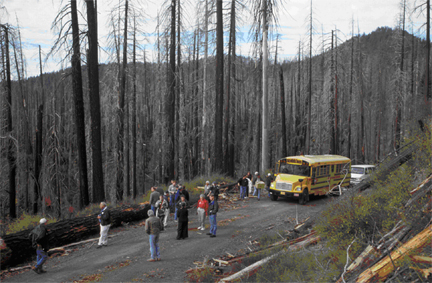
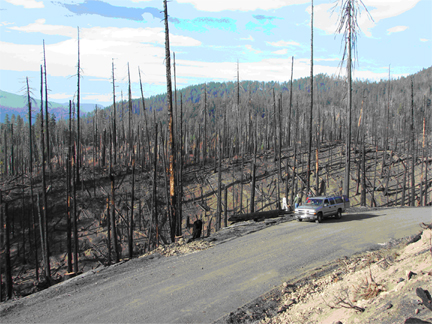
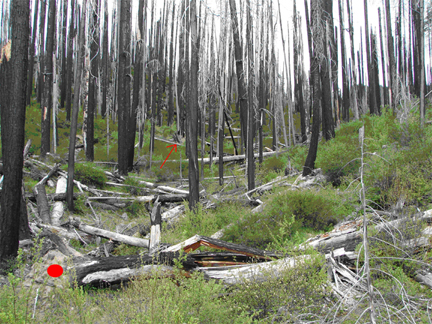
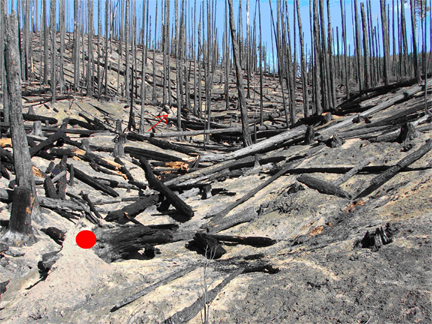
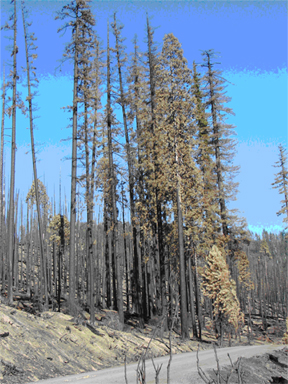
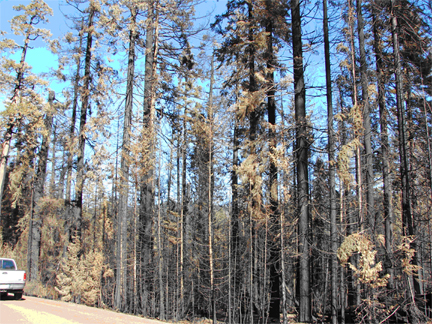
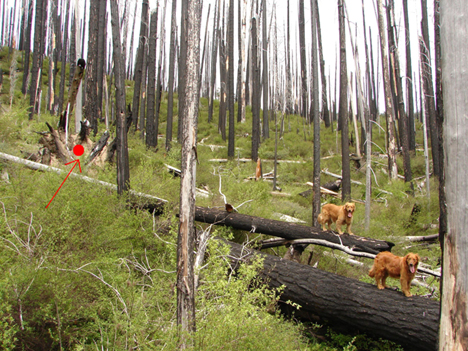

Mike:
The Enviros just don’t seem to get it, do they?
The 100 tons of dead fuels per acre consumed during this predictable reburn translates into a lot of dead animals, a lot of dead “protected” old-growth, and a whole lot of their precious CO2, gone up into smoke, deep into the atmosphere. They can’t seem to do the math or comprehend history, so maybe photographs will help.
Speaking of which — one of the captions refers to 4-8 foot brush, but the photo doesn’t show any. Are you missing a pic, or is the caption placement unclear?
Congratulations to Javier for some great photos, and for his good intentions. Someone, somewhere has to start paying attention to this unnecessary devastation and degradation sometime. I hope.